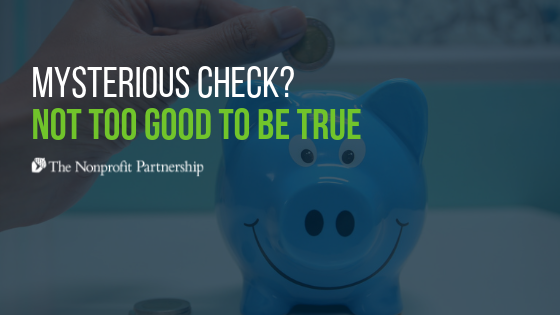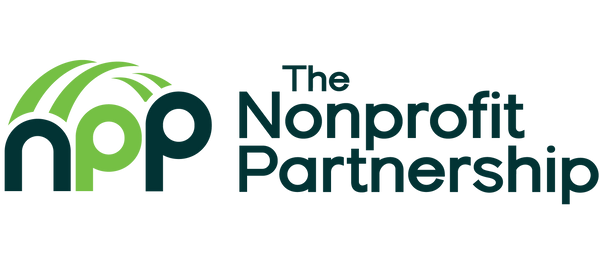
If you’ve recently received a mysterious check made out to your nonprofit from an entity called Network for Good, you may have found yourself recalling a familiar adage: “If it seems too good to be true, it probably is.”
However, there are always exceptions to the rule. In this case, you’re in luck! This check is not an elaborate scam designed to steal your organization’s routing number. Instead, it’s the result of donations made to your organization via a network of partner websites and transmitted to you by a company called Network for Good.
By day, Network for Good sells fundraising tools, including integrated fundraising pages, to nonprofits. And because the company already had experience in nonprofit fundraising and had developed a donation processing platform, they were tapped to work with Facebook (and a handful of other sites like Google and Charity Navigator) to process online donations, too.
Your organization is eligible to receive a donation via Network for Good even if you have not registered with them. Per Network for Good, “As long as your 501(c)3 is listed in Guidestar's database and has not opted out of receiving online donations, it can be eligible to be featured on one of our partners' sites.”
So how does the donation get from the donor to you? When someone donates to your organization on Facebook, Google, Charity Navigator, or another partner site, they’re technically making a donation to Network for Good’s Donor Advised Fund. Network for Good then turns around and grants that sum of money to your organization — as the donor has advised them to. This is why your organization gets one check from Network for Good, rather than individual checks with your donors’ names in the “from” column.
If you’ve received an unexpected check in the mail from Network for Good, that means you are not registered with them. Even though you don’t need to do anything proactive to begin receiving donations via Network for Good, you absolutely should register with them.
Why? You need to thank your donors. Despite the sensation you may feel when you open an envelope and discover an unexpected check and no donor list enclosed, this is not free money. This check is the result of a lot of hard work — performed over the course of weeks, months, years — carried out by your marketing, development, program, and executive staff, not to mention your volunteers and vocal supporters. They have spent umpteen hours building your organization and spreading the word about the good work it does. And it’s this hard work that has motivated real people to give their hard-earned money to your organization. This money isn’t free, it isn’t random, and it didn’t come from nowhere.
In addition, it’s a well-established fact that it is less expensive to retain donors than it is to capture new ones, and thanking (without asking, via the donor’s preferred medium, and in a timely fashion) is a huge part of stewardship, which is an essential part of the donation funnel! (And beyond that, saying thank you is just the nice thing to do.)
With these factors in mind, you have an obligation to track down whatever donor information may be available to you in order to thank your donors.
To access your donor information, you’ll first need to register with Network for Good. Registration is free, quick, and painless. To do this, visit their registration page and enter your organizations’ EIN (AKA tax ID number, found on your org’s IRS determination letter) in the box on the right side of the page. From here, you’ll be able to create a DonateNow Lite account in order to view the donor information associated with your check. (Haven’t received a check yet? You can register proactively by finding your organization in the Network for Good database, visiting your organization’s page, then registering from there. More info on that is available here.)
Here’s the sticky part. Say you’ve registered with Network for Good. You log in to your new account, excited to export your donor information so you can send out tons of beautiful, thoughtfully-composed thank you letters, but when you reach your dashboard there’s… nothing. No donor information available.
Odds are those donations came from Facebook. Remember how Network for Good partners with Facebook? And that when donors donate to you through one of Network for Good’s partner sites, it’s a pass-through donation rather than a direct donation? Unfortunately, and despite its questionable app-related data sharing practices, it is Facebook’s policy to not share donation information with third parties. In this case, Network for Good is the third party. Since the donation was not made directly to your organization, Facebook will not share the donor information with Network for Good, so they do not have it to give to you.
But wait — while you’ve missed out on getting the donor information for this check, you can avoid this painful snafu in the future by signing up for Facebook Payments. This enables your organization to directly receive donations through Facebook. When you sign up for Facebook payments, you’re now the first party rather than a third party and can access your donor information through your Facebook dashboard.
Whatever your personal opinions on Facebook, it would be a mistake to not register for the good of your organization. You should be thanking your donors for all of the compelling reasons listed above, and when you’re getting donations through Facebook or could possibly get donations through Facebook in the future, signing up for Facebook Payments is what allows you to do that.
Once your organization is registered with Facebook Payments, there’s still the slim possibility that you won’t be able to access information for every donor. But that will be because your donors have elected to remain anonymous. If this is the case, you’re fine to give up the hunt for their information, understanding that they want to give quietly and anonymously and secure in the knowledge that you've done everything you can to send that thank you.
Now that we’ve tackled your check’s origin story, let’s address this “giving system agreement” that Network for Good says you’re agreeing to by depositing this check.
Fear not: much like the check, this agreement isn’t anything to be scared of, provided your organization meets the criteria required to accept the donation. From the Network for Good website:
“[The good giving system agreement is] all the legal fine print that outlines the relationship between your organization and Network for Good when we process donations for you. Here are the highlights: (1) your agreement that we can collect donations for you, (2) your right to place a link and (if you wish) a DonateNow button on your website, (3) acknowledgement that you are a tax-exempt organization, and (4) confirmation that your donors aren’t getting goods and services in return for their donation.”
Before depositing the check, you should read the full agreement in order to determine that your organization meets all of the required criteria to be able to accept the donation. Once you’ve done that, you’re free to deposit your check!
To review:
- Your Network for Good check is the result of donations made online through Facebook, Google, Charity Navigator, or another Network for Good partner site
- If you got an unexpected check from Network for Good, it’s because your organization is not registered with Network for Good
- You should create a DonateNow Lite account with Network for Good so that you can access donor information from partner sites other than Facebook
- You should register with Facebook Payments to be able to access donor information from Facebook-based donations
- The “giving system agreement” isn’t anything to be scared of, so long as you meet the criteria laid out within the agreement
Now that you know where your check came from and understand the good giving agreement, take a few minutes to register with Network for Good and Facebook Payments. Then start writing those thank yous!

